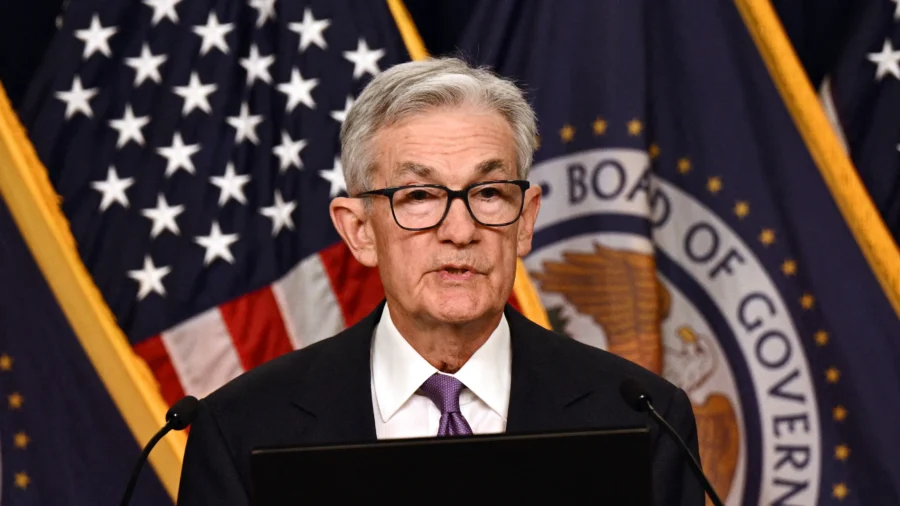The Federal Reserve left interest rates unchanged at a range of 5.25 percent and 5.50 percent at the final Federal Open Market Committee (FOMC) policy meeting of December.
Rate-setting Committee members stated that recent data suggest that economic growth has slowed from the strong third quarter. While the labor market has moderated since the beginning of 2023, employment gains remain strong as the unemployment rate has remained low. Inflation has also eased over the last year but remains above elevated, the Fed said.
“The U.S. banking system is sound and resilient. Tighter financial and credit conditions for households and businesses are likely to weigh on economic activity, hiring, and inflation. The extent of these effects remains uncertain. The Committee remains highly attentive to inflation risks,” the FOMC statement said.
Future policy decisions will be data-dependent, and officials will comb through the figures to determine if additional policy tightening is appropriate.
“The Committee will continue to assess additional information and its implications for monetary policy,” the FOMC statement said. “In determining the extent of any additional policy firming that may be appropriate to return inflation to 2 percent over time, the Committee will take into account the cumulative tightening of monetary policy, the lags with which monetary policy affects economic activity and inflation, and economic and financial developments.”
Policymakers will continue trimming the central bank’s holdings of Treasury bonds and mortgage-backed securities. The balance sheet currently sits at around $8 trillion.
The vote for a rate pause was unanimous.
At the December FOMC meeting, the Summary of Economic Projections (SEP) was updated. Officials expect the median policy rate to be 5.4 percent in 2023 and then slide to 4.6 percent in 2024 and 3.6 percent in 2025. Additionally, the Fed’s dot-plot suggests eight of the 19 officials forecasting the policy rate above the 2024 median, and five expecting it to be below.
The U.S. economy is forecast to grow 2.6 percent this year and 1.4 percent in 2024. Inflation projections were lowered, with the Fed’s preferred inflation gauge, the personal consumption expenditure (PCE) price index, expected to be 2.8 percent this year, 2.4 percent in 2024, and 2.21 percent in 2025.
Before the release of the updated SEP, officials anticipated in September that the median fed funds rate would be 5.6 percent in 2023, 5.1 percent in 2024, 3.9 percent in 2025, and 2.9 percent in 2026.
As for the economy, Fed board members and reserve bank presidents expected real GDP growth to be 2.1 percent this year and 1.5 percent in 2024. The unemployment rate was anticipated to climb to 3.8 percent in 2023 and 4.1 percent next year. PCE was forecast to be 3.3 percent this year and 2.5 percent in 2024. Officials did not expect to see inflation and core PCE reach the Fed’s 2 percent target rate until 2026.
Market Reaction
The U.S. stock market reacted positively to the news, with the leading benchmark indexes rising as much as 0.6 percent.
Treasury yields were red across the board. The 10-year yield tumbled 12 basis points to below 4.09 percent. The 2-year yield shed about 18 basis points to around 4.55 percent, while the 30-year bond declined more than 7 basis points to 4.23 percent.
The U.S. Dollar Index (DXY), a gauge of the greenback against a basket of currencies, cratered 0.5 percent to about 103.30.
Despite the jump in stocks, Giuseppe Sette, president of investment research firm Toggle AI, says the next few sessions should show if the FOMC meeting will lead to a rally or a selloff.
“No news from the Fed on Xmas. In one of the most uneventful statements this year, the Fed keeps rates unchanged and remains ready to adjust policy to new information,” Mr. Sette said in a note. “The market rallied sharply in expectation of a dovish Fed, so the next days will show us whether this FOMC meeting will lead to a case of ‘sell the news.'”
What Fed Heads Were Saying
For weeks, the speculation on Wall Street has been that the Federal Reserve will start cutting interest rates in early 2024.
In prepared remarks at Spelman College in Atlanta earlier this month, Chair Jerome Powell said it is too soon to declare victory in the central bank’s war on inflation.
“It would be premature to conclude with confidence that we have achieved a sufficiently restrictive stance, or to speculate on when policy might ease,” Mr. Powell said.
Financial markets have ostensibly disagreed and have chosen to fight the Fed. Treasury yields have tanked across the board, with the 10-year yield in a freefall since topping 5 percent. Additionally, the futures market had penciled in a rate cut as early as March before delaying it to May, according to the CME FedWatch Tool.
Speaking at Loyola University Chicago last month, Cleveland Fed President Loretta Mester argued that interest rates were in a “good place” as it balances uncertainties and current economic data.
“Monetary policy will need to be nimble and respond appropriately to the evolving outlook and to the risks to achieving both parts of our dual mandate. I believe the current level of the funds rate positions us well to do that,” Ms. Mester, who is poised to retire in June 2024, said in a speech.
The policy rate is at, or near, its peak level, and it is the most restrictive in 25 years, says New York Fed President John Williams. But everything will depend on the numbers.
“All of that said, the future remains highly uncertain, and our decisions will continue to be data-dependent,” Mr. Williams told the Bretton Woods Committee conference last month. “The risks are two-sided, with the possibility of inflation remaining stubbornly persistent weighed again the risk of a weaker economy and employment.”
The next two-day FOMC meeting will be held on Jan. 30 and 31.
From The Epoch Times


